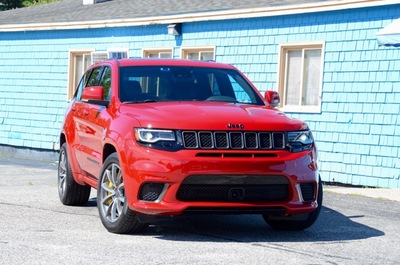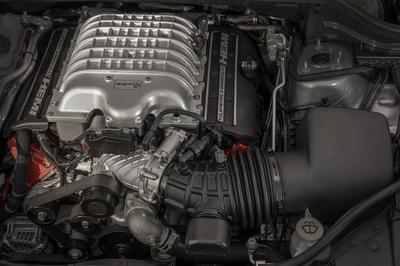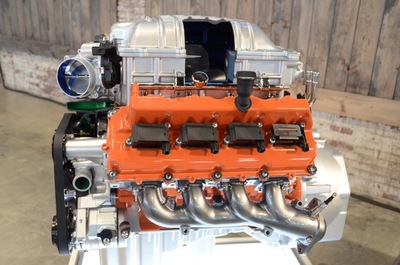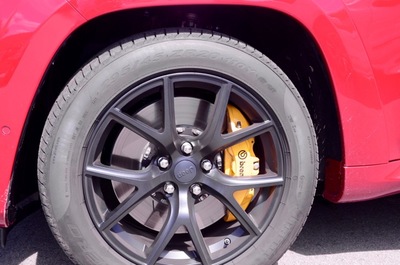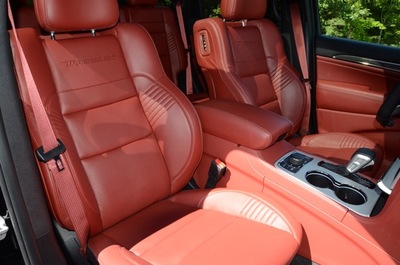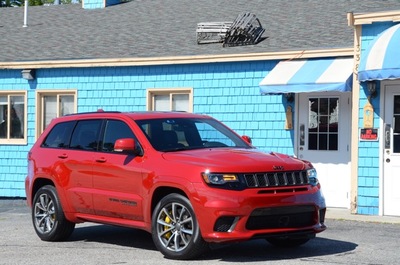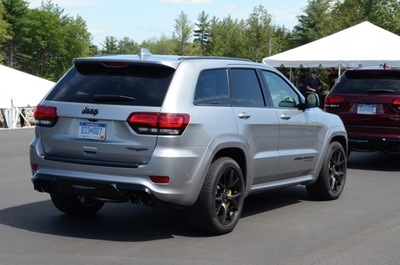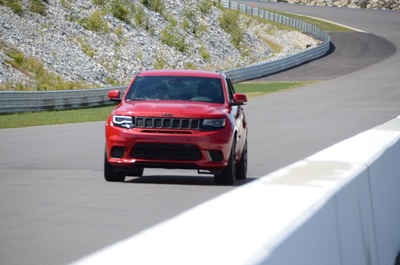2018 Jeep Grand Cherokee Trackhawk The Most Practical and Usable 700 HP Vehicle Ever - Review By Larry Nutson +VIDEO
2018 Jeep Grand Cherokee Trackhawk
The most powerful and quickest SUV ever!
By Larry Nutson
Senior Editor and Bureau Chief
Chicago Bureau
The Auto Channel
The sound of rain awakened me during the night. I was in a hotel room in Portland, Maine where the quietude allows for open-windows. Occasionally I got a whiff of salt air.
The evening before a water taxi from Portland’s Old Port waterfront where the Fore River joins Casco Bay took me past historic Fort Gorges over to Spring Point. It was cool and damp but the salt air was refreshing. I settled my appetite with some local fresh seafood, courtesy of my hosts from Jeep.
About six week earlier I got an email that read: You are invited to join the Jeep brand in Portland, Maine, for the first drive of the highly anticipated 2018 Jeep Grand Cherokee Trackhawk. Driving will include public roads in Maine and New Hampshire, as well as track time at the new Club Motorsports road course in Tamworth, New Hampshire.
The time was now! And for the coming day I didn’t want or need any rain.
The automotive enthusiast world has wondered, speculated and spread rumors about which vehicle from Fiat Chrysler Automobiles would next have the 707-horsepower Hellcat Hemi engine stuffed under its hood.
Speculation ended back in early April when the 707-horsepower 2018 Jeep Grand Cherokee Trackhawk was revealed in New York to the automotive world. Later that month the folks at Jeep hosted Midwest Automotive Media Association (MAMA) members at a meeting where we got an up close look at the Trackhawk. This detailed walk-around included hearing the rev of its powerful engine, further whetting my appetite for some time behind the wheel
Candidly, it was nice of Dodge to share their Hellcat engine with Jeep. Knowing already that two Dodge Hellcat-powered cars had been totally engineered to handle 707-horsepower, we knew there would be nothing less for the Jeep Grand Cherokee.
On the Trackhawk the 707-horsepower supercharged 6.2-liter engine is combined with an upgraded high-torque capacity TorqueFlite eight-speed automatic transmission, reworked driveline and suspension components and new Brembo brakes.
For my day with the Trackhawk I wanted both the roads and the track to be dry, because:
- 0-60 miles per hour in 3.5 seconds
- quarter mile in 11.6 seconds at 116 mph
- top speed of 180 mph
- 60-0 mph braking distance in 114 feet
- .88 g capability on the skid pad
Lest you be confused there is still a Grand Cherokee SRT with its 475-horsepower 6.4-liter V-8 that delivers 0-60 mph acceleration in 4.3 seconds, quarter-mile in 12.8 seconds and a top speed of 160 mph.
And now topping out the Grand Cherokee model lineup, Jeep brought the Trackhawk to both drive new business and satisfy customer demand, as well as compete with some of the other high-performing SUVs on the market, according to Jeep brand executives.
The engineering development and testing of the Trackhawk by FCA was handled in its entirety by SRT Engineering and SRT Powertrain. Unlike typical product development comprised of engineering by a number of specialized departments, SRT Engineering and SRT Powertrain teams do it all, from engine air intake to the tires putting the power to the road. SRT Engineering even has its own building to efficiently house this team of performance-minded engineers.
For the Trackhawk the Hellcat engine has been refined a bit with a new camshaft with revised valve timing, a new low-temperature cooling system to keep the charge air cool during performance driving, and a new fuel delivery system, featuring two high-flow, multi-mode pumps.
Packaging the engine in the Grand Cherokee required unique exhaust manifolds. In the corners of the front lower valance, instead of fog lights, there’s an oil cooler on the right and an engine cold air intake on the left. The management of heat rejection as well as engine oil control with a 1.4-G launch demanded some unique engineering.
For your curious mind, a Helmholtz resonator is used to manage supercharger noise.
The TorqueFlite eight-speed automatic transmission is beefed up and has improved shift response. The software looks at a number of variables such as engine torque gradients, kick-down events, longitudinal and lateral acceleration, grade changes, friction detection and downshift detection to determine the appropriate shift map.
Grand Cherokee’s all-wheel-drive system for the Trackhawk has a new single-speed active transfer case with a limited-slip rear differential. The differential has increased torque capacity, new gear tooth geometry for more strength, and a new four-point mount. New, stronger half-shafts are also used.
Riding one inch lower than the standard Grand Cherokee, the suspension features unique-to-the-Trackhawk Bilstein adaptive damping shocks. Brembo brakes include front 15.75-inch (400 mm) two-piece vented rotors with six-piston yellow-painted calipers, and 13.78-inch (350 mm) vented rotors with four-piston yellow calipers in the rear.
Standard wheels are 20 x 10-inch and there’s an optional forged aluminum wheel that saves a total of 12 pounds versus the standard Trackhawk wheel. Tires are all-new Pirelli 295/45ZR20 Scorpion Verde all-season and new Pirelli P Zero three-season tires with an increased speed rating are optional
And by the way, the Jeep Grand Cherokee Trackhawk is capable of towing 7,200 pounds.
Overall the Trackhawk doesn’t have a lot of bling. Supercharged badging on each side, quad exhaust outlets, and the new front fascia are key identifiers.
Climbing in, the Trackhawk features standard Nappa leather and suede seats with an embroidered “Trackhawk” logo. Looking through the flat-bottomed three-spoke steering wheel to the 7-inch driver information display instrument cluster the tachometer sits in the middle with a 200-mph speedometer off to the left side.
The instrument panel center stack has a new 8.4-inch Uconnect display featuring Trackhawk-exclusive Performance Pages where you can modify the transmission, suspension, and steering settings for Street, Sport, and Track modes.
So how is it on the street, you ask? Let’s say it’s quite docile. We spent a morning driving from Portland, crisscrossing the countryside for about 100 miles, to get to Tamworth, NH. The Trackhawk is smooth and quiet. The most you notice is a bit of exhaust rumble. Of course, if you step into the throttle to pass another vehicle it roars to life. There’s plenty of room and comfort for five and lots of SUV practicality.
The Selec-Track all-wheel-drive system has five modes--Auto, Sport, Track, Tow, Snow, and Custom. Each modifies the front-to-rear torque split, suspension firmness, and electronic stability control. We tried Sport on our drive and felt it heavied everything up too much.
Fuel economy is most likely not even a consideration with the Trackhawk. But in any case, EPA ratings are 11 city mpg and 17 highway mpg, and premium gasoline is recommended.
Mid-day we arrived at Club Motorsports, a brand new premiere country club for enthusiasts of vintage and performance cars and motorcycles at the edge of New Hampshire’s White Mountains. The track has15 turns over 2.5 miles with an elevation change of 250 feet. The road course is over 40 feet wide with a mix of long straightaways and left and right turns both uphill and downhill.
The track was dry! Thank goodness.
Following a track safety overview, Erich Heuschele, the SRT Motorsports Engineering Manager talked us through driving the Trackhawk. Most notable was him saying to simply leave the transmission selector in Drive. The software programming will do a better job of shifting up and down as well as rev-matching.
I quickly saw how well this 5000 lb. Jeep handled the turns and elevation changes of the track. A steep 14-percent uphill grade was taken with ease by the blown Hemi. Accelerating quickly on the straights the huge Brembo’s pulled you down repeatedly without fade. On the main street we were in the 110-120 mph range before jumping on the binders. In the corners there is no sense of uncertainty. The Trackhawk is very balanced and compliant. Body roll is practically non-existent.
Using Launch Control and the new Torque Reserve system many of us matched or bettered the 3.5-second zero to 60 mph time. Launch Control pre-positions the supercharger bypass valve to generate boost and minimize manifold filling time, while cutting fueling to individual cylinders and managing spark timing. This generates a reserve of torque that is instantaneously delivered upon acceleration from a standing stop.
Trackhawk orders are being taken now. It’s priced at $85,900. Add options and you can approach $100K. Wow!
But….the 2018 Jeep Grand Cherokee Trackhawk is indeed a spectacular vehicle. It’s the most practical and usable 700-horsepower vehicle ever.
© 2017 Larry Nutson, the Chicago Car Guy
This report comes from an invitation-only Jeep launch event that allowed special access to the vehicle and executives. Jeep provided my overnight accommodations, meals, and transportation.
The Most In-Depth Independent Jeep Vehicle Consumer Research - Anywhere!



